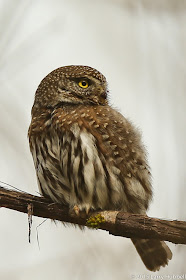The Oregon subspecies of the dark-eyed junco is a common, little bird. Juncos do not generate the excitement of a bald eagle or a barred owl. Photographers, birders and the general public seldom pause, point and proclaim, "Look, a junco!", but on closer examination they do have a certain dark-eyed beauty.
Last week, while looking for other birds, this pair caught my eye. Leaping up off the lacy branches of a western hemlock, the juncos collected insects from the limbs above their heads.
The female's "hood" is grey, while the male's is black. You can see the difference by comparing the male, in the first photo, to the female, in photos 2 through 6. Because both birds were collecting their catch, instead of eating it, I suspected they were preparing to feed their young.
The situation piqued my interest, would they return to the nest while I watched? The female, with her larger load, was the first to descend from the hemlock into the indian plum. These plums are an early blooming shrub which allows them more sunlight before the big-leafed maples shade the understory. The plum's white blossoms are already gone, their elegant, simple leaves are fully functional, while their tart little summer plums exist only in our imaginations.
The female fluttered, hopped and descended through the plum branches.
Moments later, the male followed a similar route.
He even stopped on the same branch before heading to the nest.
Unlike the female, when the male left the nest he paused to observe his surroundings. The dark space to the right of his head, is the opening to their nest.
They both returned many times with additional food.
Their nest is located in the leaves and broken twigs just below the main pedestrian-bike path in Interlaken Park. Sometimes, this ground cover is called leaf litter. This term creates the impression that decomposing plant matter should be removed. In truth, these leaves, twigs, needles, and bark are an important source of nutrients in a healthy forest; they also absorb moisture, minimize runoff and, as we just saw, provide nesting sites for native birds. When leaf litter is "cleaned up," trees receive less nutrients, and nests disappear which means less birds to eat insects, like mosquitos. In addition, the increased runoff will do more damage downstream.
Juncos are often seen on gravel paths, like this one in the Arboretum.
They hop from spot to spot, searching for tiny seeds, tucked among the stones and twigs.
Seeds are the mainstay of a junco's diet. In the spring, insects provide a special boost for the juncos and their young.
This female was seen in the Arboretum with a beak full of grass. She no doubt used the grass to line her nest. Just like the nest in Interlaken Park, this one was built in the "leaf-litter" near a trail. It is interesting, how one pair of juncos are feeding their young while another pair is still building their nest. No doubt a little diversity in timing, as in other things, increases the species' odds of survival.
From Earth Day to Independence Day, which seems surprisingly appropriate, the outdoors become a nursery for creatures large and small. Many other birds besides the juncos, like this spotted towhee, nest on or near the ground. I have no doubt my daughter's dog, Ginger, would find their eggs, or nestlings, a tasty treat. Protecting the defenseless eggs and innocent young birds, provides a special incentive for keeping our dogs properly leashed.
Speaking of special spring treats, a few days ago, I watched with a smile as this junco leaped from the ground and grabbed the dandelion just below its head. The junco rode the dandelion to the ground. While holding the plant down, the junco proceeded to separate the seeds from their parachutes.
Eva the bald eagle has finally begun sitting on her eggs, which is good to see. Last year her eggs did not hatch and this year there has been a lot of construction on 520, so this is a promising sign. There are currently nests in operation all around us.
It is prime-time to be out and about and birding on Union Bay…
...where nature nests in the city!
Larry






























































